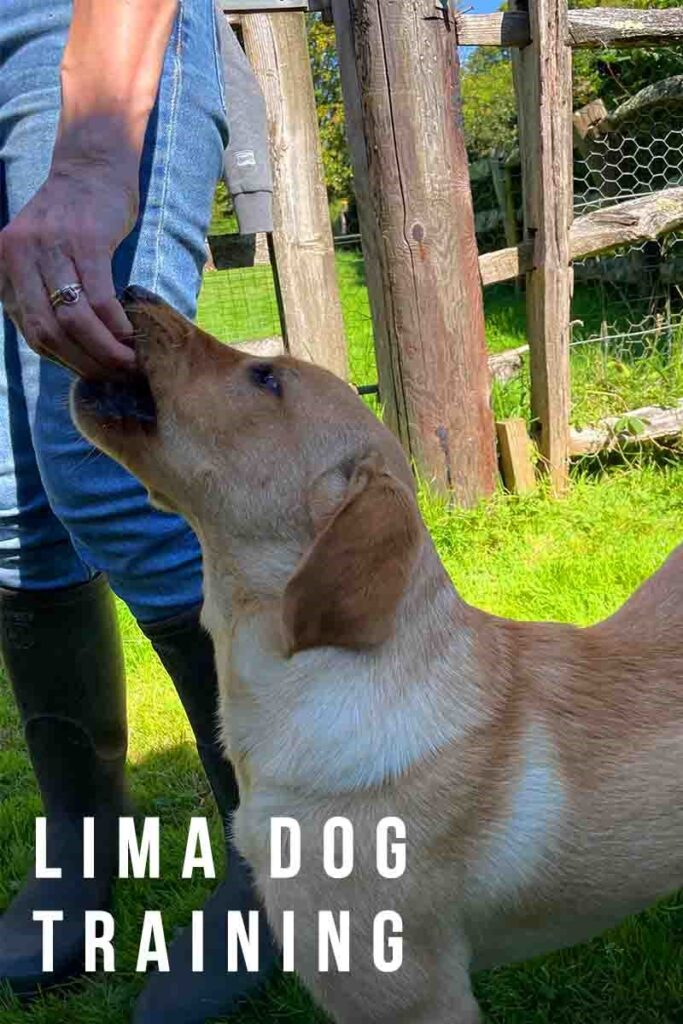LIMA dog training stands for ‘Least Invasive, Minimally Aversive’ dog training. So it’s not a specific method or protocol, but rather an over-arching philosophy, which you can apply to every training situation. Many professional dog trainers, including all those affiliated with the CCPDT and the APDT, commit to training in accordance with LIMA principles. And whether you’re ready to make the same undertaking or not, I think everyone with a dog should take time to learn about what they are, and the reasoning behind them. Because no matter how much experience you already have, can guarantee they will change how you think about your training relationship with your pup, and yourself as a trainer.
Contents
L.I.M.A.
LIMA is an acronym for ‘least invasive, minimally aversive’. It’s an evidence-based set of dog training principles, meaning that every one of them is underpinned by scientific research which corroborates their effectiveness. Let’s start with a look at what those two parts mean.
Least invasive
Training in the least invasive way possible is a really interesting concept, but not one that many of us can easily articulate. ‘Invasion’ in dog training can mean:
- Intruding on your dog’s physical space (for example pushing their butt down to achieve a sit position).
- Restricting their freedom to learn by making their own choices (for example by using excessive crating to control boisterous behavior, instead of capturing and rewarding calm moments outside of the crate).
- And even tactics that overstep their emotional boundaries. A classic example of this is the long-discredited concept of reducing reactivity by ‘flooding’ them with exposure to the trigger.
Minimally aversive
Aversives in dog training are much easier to pin down. They are consequences which make a dog less likely to repeat the same behavior. Some training tools are obviously aversive, such as electric shock collars and prong collars. But almost anything that can become aversive, if it is misused. Perhaps the best example is our own voice. Our voice can be a positive reinforcement (for example when it predicts a treat), or aversive (for example an angry shout).
Aversive training methods work by making the dog’s life worse when they do the ‘wrong’ thing. And avoiding them isn’t just about canine welfare, it’s pragmatic too. We know that stress disrupts and inhibits learning, for a start. Using aversives in training can also give rise to a host of unintended consequences, like increased fearfulness, reactivity, and aggression. So, by adopting the least aversive training approach possible dogs are happier, learn faster, and your training efforts are less likely to backfire.

The humane hierarchy
At the core of LIMA dog training is the ‘humane hierarchy’. Basically these are all the approaches we can use to change dogs’ behavior, organized by how intrusive and aversive they are. The aim is to seek a solution from the lowest tier possible, using the least intrusive and aversive methods to achieve your goal. You should only escalate to the next tier once the potential for finding a solution from the previous tier has been completely exhausted.
The humane hierarchy of ways to change a dog’s behavior (starting at the bottom) is:
- Assessing health, nutritional and physical factors.
- Antecedents.
- Positive reinforcement
- Differential reinforcement of alternative behavior
- Negative punishment, negative reinforcement, or extinction
- Positive punishment
I remember them in the right order by saying ‘Always Act Positively, Do Not Punish’ to myself! Now let’s work our way through them, from the bottom up.
1. Addressing health, nutritional and physical factors
In other words, changing unwanted behavior should start with a trip to the veterinarian to rule out medical causes, and by looking at their diet and their environment. For example, a dog who gets up frequently in the night and behaves restlessly or asks to go outside could be experiencing a urinary tract infection, canine cognitive dysfunction, or the onset of arthritis. Medicines to manage their symptoms, or environmental changes like a more supportive bed, are what’s needed to change their behavior.
2. Antecedents
Antecedents means ‘things that come first’. In Pippa’s training guides, she frequently talks about ‘setting the dog up to succeed’. This is very similar to addressing antecedents in LIMA dog training. A good example is getting rid of distractions. If your dog ignores their recall cue in the dog park, it’s because they haven’t been trained to respond correctly surrounded by so many distractions. Setting them up to succeed, or fixing your antecedents, is proofing their recall in a low-distraction environment first, then adding bigger distractions in a gradual and methodical way.
Another example is a dog who barks at people passing by your window. Seeing the passer by is the antecedent for the barking. Putting up shutters, blinds or frosted window film so that your dog can’t see them will reduce or eliminate the unwanted barking.
3. Positive reinforcement
Positive reinforcement means creating an outcome for a behavior that increases the probability of the dog doing the same thing again. It works because it makes the dog’s life better when they make the choices we want. For example when we introduce a puppy to their new crate, we hide treats in it when they aren’t looking. Then when they explore the crate of their own accord, they’re met with a delicious surprise. This makes them more likely to explore it and spend time in it in future, which is a vital first step before getting them used to having the door closed, and ultimately leaving them shut in. Remember, a key quality of positive reinforcement is that your dog decides what’s reinforcing. There’s no point in you deciding that verbal praise should be enough. If it isn’t working you need to find something genuinely rewarding, like food, or access to a favorite toy.
For me, an interesting and important quality of LIMA dog training is that we made it nearly half way through the humane hierarchy before we even tried to change a dog’s behavior by introducing consequences! I think a lot of us (and I include myself in that) are often too quick to assume that the only way to change our pet’s behavior is by changing them, and overlook the significance of health, nutritional and physical factors and antecedents first.
4. Differential reinforcement of alternative behavior
This is all about focussing on what you do want the dog to do, and making it more rewarding than whatever they’re doing instead.
A good example is when a dog learns that it’s rewarding to jump up at people’s legs, because people responded by greeting and petting him when he was a puppy. In this scenario, the problem behavior is the jumping up, and the maintaining reinforcer is the positive attention he receives for it. An acceptable replacement behavior would be to sit in front of you with all four paws on the ground while you greet him and pet him. So, let’s put LIMA principles into action!
- First, you’re going to start rewarding him for stopping short of you with all four paws on the floor when he comes in to say ‘hi’ (reinforcing an acceptable alternative behavior).
- And second, you’re going to ‘be a tree’ and stop petting him when he jumps up (removing the maintaining reinforcer for jumping up).
For help with the first part, take a look at this article from Pippa about stopping jumping up.
5. Negative punishment, negative reinforcement, or extinction
These three terms have similar but subtly distinct meanings.
- Negative punishment is when you withdraw something your dog enjoys when they do something you don’t want them to do, in order to reduce the likelihood of them doing it again. For example, going to the other side of a puppy gate when your puppy bites your ankles. Access to you is a powerful reinforcer for puppies, so withdrawing it specifically when they bite decreases the likelihood of them biting your ankles again.
- Negative reinforcement means removing something your dog doesn’t like at the moment they do the thing you want them to do, so that they’re more likely to do it again in future. The classic example of this is pushing down on their butt to make them sit, releasing the pressure when they sit, and reapplying it if they lift their butt again. They will start sitting more in order to avoid being manhandled.
- Extinction means removing the rewarding result of something, so that the dog becomes less likely to continue repeating it.
Why is extinction here?
Interestingly, in strict LIMA terms, these three approaches all occupy an equal position in the humane hierarchy. I say this is interesting, because we tend to think of extinction as being more neutral than the other two. For example ignoring barking so that your dog stops using it to get attention. But, relying on extinction also has a lot of potential to backfire:
- Behaviors usually go through an ‘extinction burst’ before they die out. This is when dogs just try doing them more, to achieve the same result they used to have. For example barking more forcefully to get your attention.
- It can be very difficult to consistently ignore an unwanted behavior. And if you relent, the dog just learns that they need to do more of it than before to achieve the result they’re seeking.
- Pressing one behavior towards extinction can resurrect a different one. Sticking with our barking example, your dog will still want attention, so they might resume nipping your legs or chewing the table leg to get it.
- The process is inevitably confusing and stressful for your dog, who is only trying to communicate (invasion on their mental wellbeing).
All of which combines to earn extinction a place right up here in the penultimate tier. According to LIMA principles, a less invasive, less aversive solution is to anticipate that your dog needs interaction and engagement from you, and supply it before they need to ask by barking.
6. Positive punishment
Positive punishment means making things worse for your dog when they do something undesirable, so they’re less likely to do it again. Like kicking them when they bark, using a prong collar when they pull on the lead, or activating an electric shock collar when they ignore their recall cue. It’s the ‘other end’ of the humane hierarchy. And it’s really included for completeness, so that the hierarchy includes all the methods that have the effect of changing a dog’s behavior. But LIMA principles are clear: there is no justification for ever using this tier. You can’t use the humane hierarchy to justify eventually ending up at positive punishment. A solution from the lower tiers does exist, and is more appropriate, in every scenario. What’s more the counter productive and damaging effects of positive punishment in dog training are well established.
LIMA is about you too!
Are you used to thinking that dog training is about, well, your dog? Think again! A core principle of LIMA training – and certainly the most thought provoking for me when I first learned about it – is the importance of trainer competence. This means:
- Committing to staying abreast of modern training research.
- Recognizing that no one is an expert on everything, and you have gaps in your knowledge too.
- Asking for help when a training problem is outside your experience.
This is important because when we don’t recognize our own shortcomings, we’re more likely to assume that the most appropriate next step in training is to move up to the next tier of the humane hierarchy, and miss a better solution from the lower tiers.
Finding a LIMA trainer compliant trainer
Anyone can embrace the LIMA training philosophy. I would go so far as to say that everyone will be made a better trainer for learning about them. They contain lots of food for thought. The Certification Council for Professional Dog Trainers (CCPDT) and the APDT both require their members to follow LIMA principles. Their websites have facilities for searching for a trainer near you.
It’s always worth asking a dog trainer whether they follow LIMA principles before you work with them. The term LIMA has only become widely used in dog training in the last 5 – 10 years. A dog trainer who looks blank when confronted with it has not refreshed their knowledge of training best practice in quite some time! So who knows what else they’ve missed?
LIMA dog training – summary
LIMA training mean achieving your dog training goals using the least invasive, minimally aversive methods possible. Underpinning this is the principle that if a less invasive, more minimally aversive approach exists, it is fundamentally cruel and unjustified to skip over it in favor of a more invasive and aversive approach. The humane hierarchy sets out the order possibilities for changing a dog’s behavior should be considered in. Part of being a good LIMA trainer is always asking for help from someone with more experience before you escalate from one level of the hierarchy to another.
What do you think of LIMA dog training principles? Let us know in the comments box down below.
The Labrador Site Founder
Pippa Mattinson is the best selling author of The Happy Puppy Handbook, the Labrador Handbook, Choosing The Perfect Puppy, and Total Recall.
She is also the founder of the Gundog Trust and the Dogsnet Online Training Program
Pippa's online training courses were launched in 2019 and you can find the latest course dates on the Dogsnet website


















